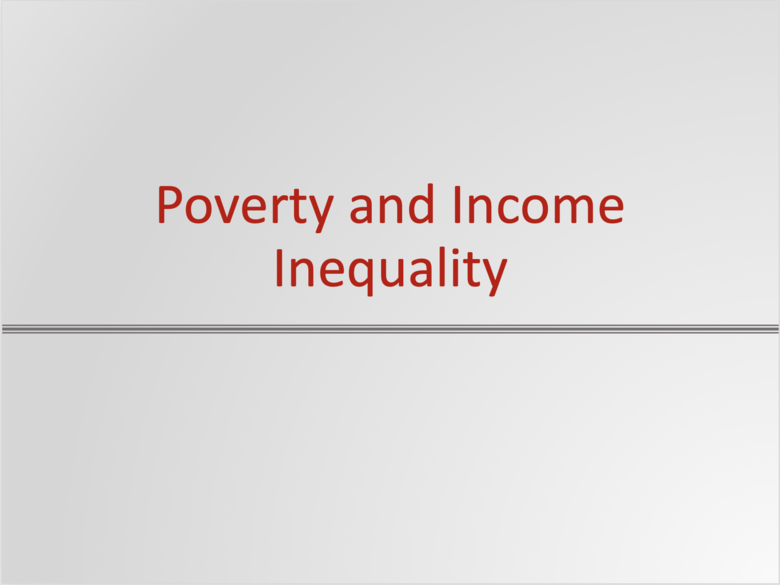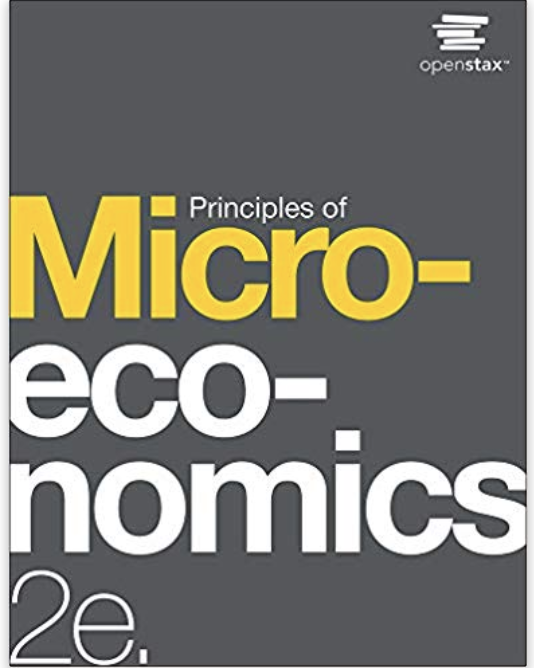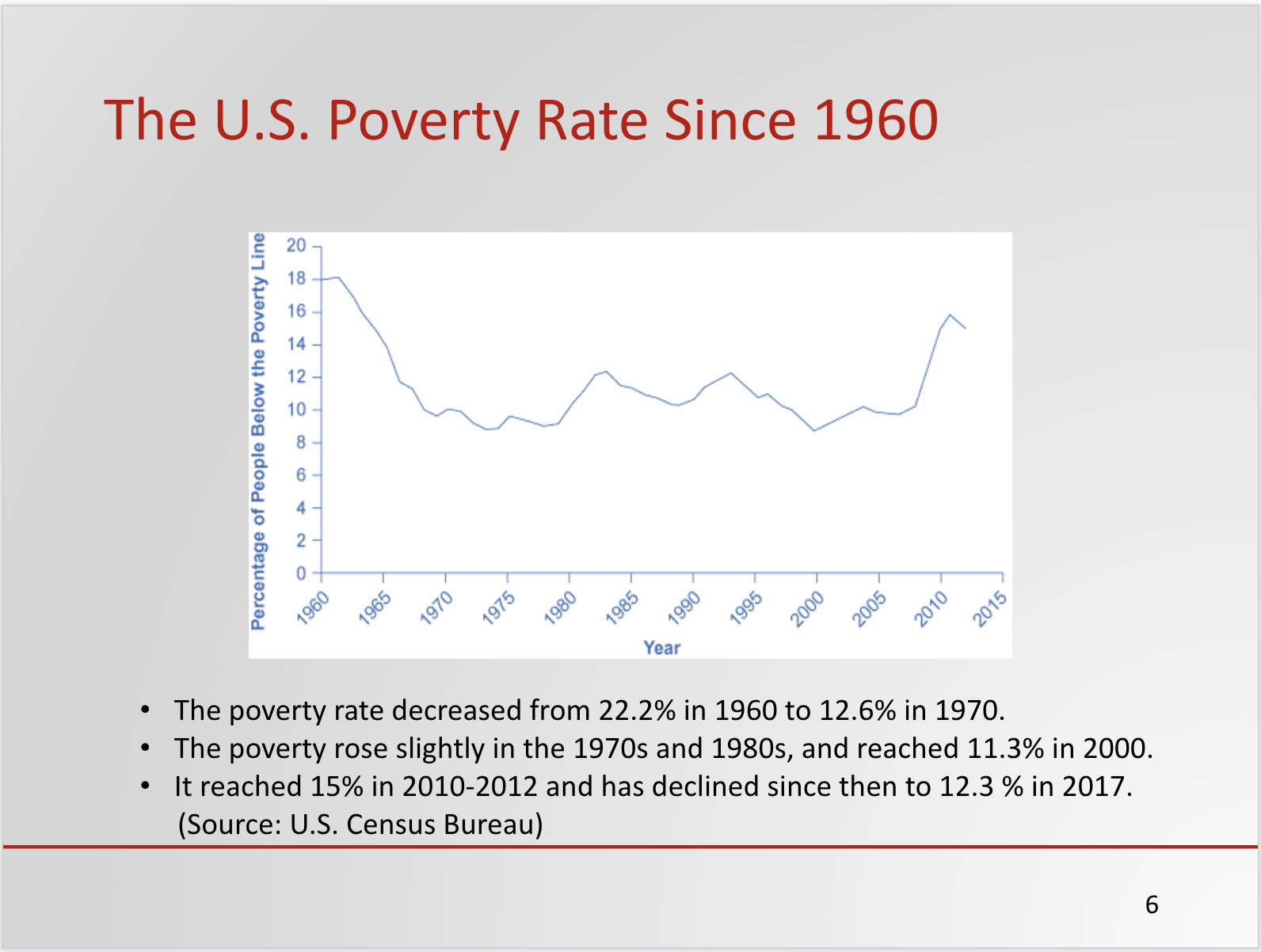Income Inequality, Poverty and Discrimination Resources

Overview
This topic examines income inequality, poverty, and discrimination in the U.S. and around the world. The focus is on the U.S. with comparative discussion on other select nations. It provides evidence on poverty trends and a discussion on the causes of poverty. It also provides evidence on income distribution and a discussion on the causes of income inequality. The impact of discrimination on wage earnings is examined. There is an emphasis on policy measures to address poverty and income inequality.
Learning Objectives
- Explain how the poverty line is determined (14)
- Explain how income inequality is measured (14)
- Identify and discuss the causes of poverty and income inequality (2,13,14)
- Describe trends in the poverty rates and income inequality over time (13,14)
- Identify and explain differences in poverty rates across different populations (14)
- Identify and describe government programs to reduce poverty and income inequality (2,13,14)
- Explain the role of discrimination in poverty and income inequality (13,14)
- Explain the potential benefits and costs of government income redistribution and antipoverty measures (2,13,14)
- Compare poverty rates and income inequality across different countries (13,14)
- Identify the causes of poverty and income inequality across different countries (13,14)
NOTE: This Module meets Ohio TAG's 2, 13, and 14 for an Intro to Microeconomics Course OSS004
Recommended Textbook Resources
Principles of Microeconomics 2e 
Full Citation: Taylor, T., Greenlaw, S. et. al. (2017) “Poverty and Income Distribution” Principles of Microeconomics 2nd Ed. OpenStax CNX.
Chapter 15: Introduction to Poverty and Economic Inequality
Chapter 14: Section 14.5 Employment Discrimination
These two resources provide a broad discussion of income inequality, poverty, and discrimination. Chapter 15 covers all the learning objectives except for discrimination. Section 14.5 covers issues on the impact of discrimination on wage earnings, which has a direct impact on poverty and income inequality. Instructors will find the resources useful as they employ data from the Census Bureau and The World Bank to review U.S. trends and global trends over time.
Supplemental Content/Alternative Resources
Video Resource
Income and Wealth Inequality: Crash Course Economics #17
This short video explains wealth inequality and income inequality globally. It outlines the courses of income and wealth inequality over time including technology, globalization, wage inequality, and discrimination. It identifies the consequences of income inequality and proposed strategies to reduce income inequality. Some of the examples may be dated, but it is a quick outline of many of the issues related to income inequality.
Scholarly Article
The Consequences of Economic Inequality
Birdsong, Nicholas (2015). Seven Pillars Institute (All Rights Reserved)
This is a good article that outlines various debates on income inequality including its causes and consequences. It can serve to inform class discussion and exercises.
US Census Bureau Statistics
The following links contain information and data from the US Census Bureau on income inequality and poverty. Instructors may update data in the recommended texts by going to these links.
- Income and Poverty in the United States 2017: Published in September, 2018, this updates data on income and poverty in the U.S. in 2016 and 2017. Data on shares of aggregate income by percentile are contained in Table 2 and data on poverty by selected characteristics are contained in Table 3.
- Historical Income Tables, Income Inequality: Historical data on income distribution and mean household incomes (Historical Poverty Tables: People and Families - 1959 to 2018 ) are provided in Tables H-2 and H-3, respectively.
World Bank Statistics
The following links contain information and data from the World Bank on poverty and income inequality in many developing countries. Since poverty is usually more severe in the developing regions of the world, an instructor may use these data for comparative purposes.
Poverty headcount ratio at $1.90 a day (2011 PPP) (% of population): This link allows for comparative data on income shares held by different quintiles in different developing countries in 2017.
Poverty & Equity Data Portal: This link allows a student to explore poverty trends in various countries and regions of the world, 1990 to 2015.
Other Poverty Statistics
- Ohio Development Services Agency: The Ohio Poverty Report, February 2019: This reports on trends and changes in poverty over time (1959-2017). Mostly derived from the 2018 Community Survey, it compares Ohio to the rest of the nation, examines variations among Ohio’s counties and populations, and discusses economic variables impacting poverty trends and variations.
- Hans Rosling - TED 2007 New Insights on Poverty: Hans Rosling’s presentation gives insights on poverty across countries and regions of the world. Using historical data on poverty across countries, it provides a comparative discussion with a focus on how economic development has reduced poverty over time.
Active Learning Exercise
Discussion:
- An important part of the discussion on poverty in the U.S. concerns government programs to alleviate poverty. For TANF, EITC, and SNAP, ask that students submit a short discussion on the intended consequences and unintended consequences of each program. Students should focus on (i) how and why each program should impact the poverty rate over time, and (ii) how each program may potentially increase or decrease the chances of a poverty trap.
Discussion:
- Economists always point to the issue of “equity versus efficiency” when debating how and when to address income inequality. Proposed measures to address income inequality include changes in personal and corporate tax structure, and policies to reduce discrimination and wage inequality, and increase investments in education, especially among minority populations. First, explain why the issue of “efficiency versus equity” is important to the debate on income inequality. Second, for each proposed measure, identify its intended consequence(s) and unintended consequence(s).Here is a good article that addresses several aspects of the issue: https://sevenpillarsinstitute.org/consequences-economic-inequality/
Data Exercise:
- The following are links to data sources on poverty and income inequality in the U.S. Ask that students to review five- to ten-year data on poverty in the U.S. and income distribution. Discuss the possible reasons for increases or decreases in income inequality and poverty over time.
- Income and Poverty in the United States, 2017: Published in September, 2018, this updates data on income and poverty in the U.S. in 2016 and 2017. Data on shares of aggregate income by percentile are contained in Table 2 and data on poverty by selected characteristics are contained in Table 3.
- Historical Income Tables: Income Inequality: Historical data on income distribution and mean household incomes (1967 to 2017) provided in Tables H-2 and H-3, respectively
- Historical data on US poverty 1959 to 2017
Data Exercise:
The following links provide poverty and income distribution data in different developing countries. Assign each team of students to a World Bank Region (may include sub-Saharan Africa, Middle East and North Africa, Europe and Central Asia, South Asia, East Asia, and Latin). Compare poverty and income distribution trends among countries in each region and identify policies to alleviate poverty in these countries.
- Poverty headcount ratio at $1.90 a day (2011 PPP) (% of population): Go to the listed information on the right and it allows for comparative data on income shares held by different quintiles in different developing countries in 2017.
- Poverty & Equity Data Portal: Explore poverty trends in various countries and regions of the world, 1990 to 2015.
Questions and Problems
Income Inequality, Poverty and Discrimination
Questions and Problems
Instructors can add a Google Doc of the Income Inequality, Poverty and Discrimination Questions and Problems to their Google Drive or download a Word File of the Income Inequality, Poverty and Discrimination Questions and Problems.
Questions:
- Generally, in the US black and Hispanic populations have relatively higher poverty rates than white populations. Identify possible reasons why this is the case.
- How would government policy that encourages investments in education and reduction in racial discrimination impact poverty?
- It is generally expected that for any nation increases in economic growth will cause a decrease in poverty rates. Would you also say that for any nation, increases in economic growth will lead to a reduction in income inequality? Why or why not?
- Explain how varying demand for high-skilled labor and low-skilled labor may have contributed to income inequality in the U.S.
- In the US an individual is considered to be in poverty when her income falls below the poverty income threshold defined as three times the amount of income necessary for meet an adequate level of nutrition. Identify any drawbacks with this measure.
- What are the current international threshold poverty incomes used by The World Bank? What has happened to global poverty rates over time? Refer to the following link: http://povertydata.worldbank.org/poverty/home/
- Using current data from the U.S. Census Bureau, compare the poverty rates of different racial groups in the U.S. since 2000. Which groups have experienced the most significant changes in poverty rates?
- During a class study session another student said: Poverty rate for a nation means the same as income inequality. Do you agree with her?
Answers:
- Based on recent U.S. Census Bureau data, overall poverty rates have decreased since 2010. However, poverty rates for blacks and Hispanics have remained relatively high. Reasons include educational attainment, discrimination in employment and housing, and access to healthcare.
- These policies enable workers to increase human capital and provide access to skills and knowledge necessary to build wealth for subsequent generations and access to healthcare. Reductions in racial discrimination help reduce crime rates among minority populations.
- Based on data from the U.S. Census Bureau and The World Bank, poverty rates have decreased in the U.S. and developing countries since 2011. Due to stronger economies, employment and overall household incomes have increased. If most of the rise in income have accrued to the top income earners (top 5%-20%), the aggregate share of income to the top income earners may increase, in spite of the overall reduction in poverty rates.
- Due to globalization, increased demand for high-skilled labor has exceeded increased supply of high-skilled labor leading to increases in equilibrium wages for high-skilled labor. Wage increases have accrued disproportionately to high-skilled workers.
- The cost of living varies between cities and it needs to be adjusted to differences in the cost of living. It is based on cash income and in-kind transfers are not included.
- Referring to the link provided in the question, the international poverty line is normally set at US$1.90 a day (2011 purchasing power parity). Overall poverty rates have declined from 35.9% in 1990 to 9.9% in 2015. Students may explore poverty rates for specific regions and countries as well.
- The information can be found by going to the following link: https://www.census.gov/data/tables/time-series/demo/income-poverty/historical-poverty-people.html
- Disagree. Poverty rate refers to the percentage of the population that has income below the threshold income level. Income inequality refers to the relative changes in aggregate income shares going to groups with different income levels.
